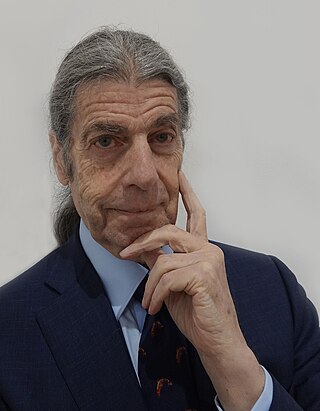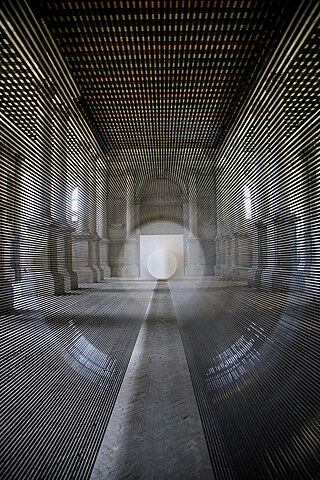
Angela Bulloch, is an artist who often works with sound and installation; she is recognised as one of the Young British Artists. Bulloch lives and works in Berlin.

Jean-Marc Bustamante is a French artist, painter, sculptor and photographer. He is a noted conceptual and installation artist and has incorporated ornamental design and architectural space in his works.

Pierre Bismuth is a French artist and filmmaker based in Brussels. His practice can be placed in the tradition of conceptual art and appropriation art. His work uses a variety of media and materials, including painting, sculpture, collage, video, architecture, performance, music, and film. He is best known for being among the authors of the story for Eternal Sunshine of the Spotless Mind (2004), for which he won the Academy Award for Best Original Screenplay alongside Michel Gondry and Charlie Kaufman. Bismuth made his directorial debut with the 2016 feature film Where is Rocky II?.

John Armleder is a Swiss performance artist, painter, sculptor, critic, and curator. His work is based on his involvement with Fluxus in the 1960s and 1970s, when he created performance art pieces, installations, and collective art activities that were strongly influenced by John Cage. However, Armleder's position throughout his career has been to avoid associating his artistic practice with any type of manifesto.
Bethan Huws is a Welsh multi-media artist whose work explores place, identity, and translation, often using architecture and text. Her work has been described as "delicate, unobtrusive interventions into architectural spaces".
Jean-Michel Sanejouand was a French artist. His work ranged from environments to monumental sculptures, from readymade-like objects, to paintings of oneiric landscapes in which (usually) one of his sculptures stands.

Adel Abdessemed is an Algerian-French contemporary artist. He has worked in a variety of media, including animation, installation, performance, sculpture and video. Some of his work relates to the topic of violence in the world.
Haim Steinbach is an Israeli-American artist, based in New York City. His work consists of arrangements of everyday objects, presented in “Displays” and shelves of his own making.

Žilvinas Kempinas is a contemporary visual artist. He lives and works in New York City.

Tatiana Trouvé is am Italian visual artist based in Paris who works in large-scale installations, sculptures, and drawings. Trouvé is the recipient of numerous awards including the Paul Ricard Prize (2001), Marcel Duchamp Prize (2007), ACACIA Prize (2014), and Rosa Schapire Kunstpreis (2019). Trouvé has taught at the École nationale supérieure des Beaux-Arts in Paris since 2019.
Pierre Clerk is a contemporary artist who works primarily in painting and sculpture.

William MacKendree is an American artist. He was born in Augusta, Georgia in 1948. He studied Philosophy and Visual Arts at Georgia State University in Atlanta. Following the completion of his university degrees, he left the U.S. to live and work in Greece between 1975 and 1982.
Melik Ohanian is a French contemporary artist of Armenian origin. He lives and works in Paris and New York City. His work has been shown in many solo exhibitions including Galerie Chantal Crousel, Centre Pompidou and Palais de Tokyo in Paris, South London Gallery in London, De Appel in Amsterdam, IAC in Villeurbanne, Yvon Lambert in New York, Museum in Progress in Vienna, and Matucana 100 in Santiago de Chile.

Catherine Gfeller is a Swiss artist. She currently lives and works in Paris and Southern France after having lived in New York from 1995 to 1999.
Hugo Markl is a contemporary American artist, curator, and creative director. He studied Visual communication at the University of Applied Arts Vienna (1985–90) where he graduated with an M.A. in fine arts. His practice spans a broad range of media including sculpture, photography, video, drawing, printmaking, installation art, and performance. Markl lives in New York City.

Florian Froehlich, is a contemporary artist who creates paintings, sculptures, stained-glass, and installations.

Oliver Beer is a British artist who lives and works in Kent and Paris. He graduated in 2009 from the Ruskin School of Drawing and Fine Art, University of Oxford, England and in 2007 from the Academy of Contemporary Music in England.

Arik Levy was born in Tel Aviv. An artist and industrial designer, he attended the Art Center Europe in Switzerland where he graduated with distinction in 1991. Levy employs a multi-disciplinary approach in both the art and industrial design fields. His works have been included in multiple museum collections. Levy lives and works in Paris.

Pierrette Bloch was a Paris-born Swiss painter and textile artist.

Didier Vermeiren is a Belgian sculptor.

















